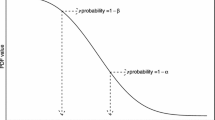Abstract
Estimating financial risk is a critical issue for banks and insurance companies. Recently, quantile estimation based on extreme value theory (EVT) has found a successful domain of application in such a context, outperforming other methods. Given a parametric model provided by EVT, a natural approach is maximum likelihood estimation. Although the resulting estimator is asymptotically efficient, often the number of observations available to estimate the parameters of the EVT models is too small to make the large sample property trustworthy. In this paper, we study a new estimator of the parameters, the maximum Lq-likelihood estimator (MLqE), introduced by Ferrari and Yang (Estimation of tail probability via the maximum Lq-likelihood method, Technical Report 659, School of Statistics, University of Minnesota, 2007 http//:www.stat.umn.edu/~dferrari/research/techrep659.pdf). We show that the MLqE outperforms the standard MLE, when estimating tail probabilities and quantiles of the generalized extreme value (GEV) and the generalized Pareto (GP) distributions. First, we assess the relative efficiency between the MLqE and the MLE for various sample sizes, using Monte Carlo simulations. Second, we analyze the performance of the MLqE for extreme quantile estimation using real-world financial data. The MLqE is characterized by a distortion parameter q and extends the traditional log-likelihood maximization procedure. When q→1, the new estimator approaches the traditional maximum likelihood estimator (MLE), recovering its desirable asymptotic properties; when q ≠ 1 and the sample size is moderate or small, the MLqE successfully trades bias for variance, resulting in an overall gain in terms of accuracy (mean squared error).
Similar content being viewed by others
References
P. Artzner, F. Delbaen, J. M. Eber, and D. Heath, “Coherent measures of risk,” Mathematical Finance vol. 9 pp. 203–228, 1999.
A. A. Balkema and L. de Haan, “Residual life time at great age,” The Annals of Probability vol. 2 pp. 792–804, 1974.
C. Brooks, J. Clare, J. Dalla Molle, and G. Persand, “A comparison of extreme value theory approaches for determining value at risk,” Journal of Empirical Finance vol. 22 pp. 1–22, 2005.
E. Castillo, J. María, and A. S. Hadi, “Fitting continuous bivariate distributions to data,” The Statistician: Journal of the Institute of Statisticians vol. 46 pp. 355–369, 1997.
R. Cont, “Empirical properties of asset returns: stylized facts and statistical issues,” Quantitative Finance vol. 1(2) pp. 223–236, 2001.
P. Embrechts, C. Kluppelberg, and T. Mikosch, Modelling Extremal Events for Insurance and Finance, Applications of Mathematics, Springer, 1997.
T. S. Ferguson, A Course in Large Sample Theory, Chapman & Hall Ltd, 1996.
D. Ferrari and Y. Yang, “Estimation of tail probability via the maximum Lq-likelihood method,” Technical Report 659, School of Statistics, University of Minnesota, 2007. http://www.stat.umn.edu/~dferrari/research/techrep659.pdf.
R. Fisher and L. C. Tippett, “Limiting forms of the frequency distribution of largest or smallest member of a sample,” Proceedings of the Cambridge philosophical society vol. 24 pp. 180–190, 1928.
M. Gell-Mann (ed.), Nonextensive Entropy, Interdisciplinary Applications, Oxford University Press: New York, 2004.
M. Gilli and E. Kellezi, “An application of extreme value theory for measuring financial risk,” Computational Economics vol. 2–3 pp. 207–228, 2006.
G. H. Givens and J. A. Hoeting, Computational Statistics, Wiley: New Jersey, 2005.
B. V. Gnedenko, “Sur la distribution limite du terme d’une serie aleatoire,” Annals of Mathematics vol. 44 pp. 423–453, 1943.
S. D. Grimshaw, “Computing maximum likelihood estimates for the generalized Pareto distribution,” Technometrics vol. 35 pp. 185–191, 1993.
T. Hastie, R. Tibshirani, and J. H. Friedman, The Elements of Statistical Learning: Data Mining, Inference, and Prediction: With 200 Full-color Illustrations, Springer-Verlag Inc., 2001.
J. Havrda and F. Charvát, “Quantification method of classification processes: Concept of structural entropy,” Kibernetika vol. 3 pp. 30–35, 1967.
J. R. M. Hosking and J. R. Wallis, “Parameter and quantile estimation for the generalized Pareto distribution,” Technometrics vol. 29 pp. 339–349, 1987.
P. J. Huber, Robust Statistics, Wiley Series in Probability, John Wiley and Sons, 1981.
A. F. Jenkinson, “The frequency distribution of the annual maximum (minimum) values of meteorological events,” Quarterly Journal of the Royal Meteorological Society vol. 81 pp. 158–172, 1955.
J. Knight, S. Satchell, and G. Wang, “Quantitative finance,” vol. 3 pp. 332–344, 2005.
K. Kuester, S. Mittnik, and M. Paolella, “Value-at-risk prediction: A comparison of alternative strategies,” Journal of Financial Econometrics vol. 4(1) pp. 53–89, 2006.
N. A. Lazar, Statistics of Extremes: Theory and Applications, Wiley: England, 2004.
A. McNeil and R. Frey, “Estimation of tail-related risk measures for heteroskedastic financial time series: an extreme value approach,” Journal of Empirical Finance vol. 7 pp. 271–300, 2000.
A. McNeil and A. Stephenson, evir: Extreme Values in R, 2007. http://www.maths.lancs.ac.uk/~stephena/. R package version 1.5. S original (EVIS) by Alexander McNeil and R port by Alec Stephenson.
A. McNeil, R. Frey, and P. Embrechts, Quantitative Risk Management: Concepts, Techniques and Tools, Princeton Series in Finance: New Jersey, 2005.
R Development Core Team. R: A Language and Environment for Statistical Computing. R Foundation for Statistical Computing, Vienna, Austria, 2006. http://www.R-project.org.
R. Reiss and M. Thomas, Statistical Analysis of Extreme Values with Applications to Insurance, Finance, Hydrology and Other Fields, Birkhauser Verlag: Basel, 1997.
M. A. Ribatet, A users guide to the pot package (version 1.0), 2006. http://cran.r-project.org.
A. van der Vaart, Asymptotic Statistics, Cambridge University Press: New York, 1998.
R. von Mises, La distribution de la plus grande de n valeurs, in selected papers, volume II, vol. 44 of American Mathematical Society, Providence, RI, 1954.
Author information
Authors and Affiliations
Corresponding author
Rights and permissions
About this article
Cite this article
Ferrari, D., Paterlini, S. The Maximum Lq-Likelihood Method: An Application to Extreme Quantile Estimation in Finance. Methodol Comput Appl Probab 11, 3–19 (2009). https://doi.org/10.1007/s11009-007-9063-1
Received:
Revised:
Accepted:
Published:
Issue Date:
DOI: https://doi.org/10.1007/s11009-007-9063-1




